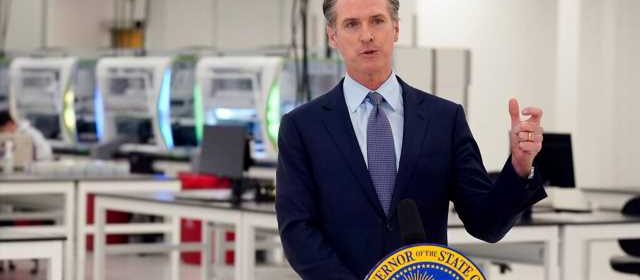California ignores public records request, keeps coronavirus data hidden

Over 50 business owners sue Gov. Newsom for outdoor dining ban
Small business owners Carl Dene and Cynthia Ariosta provide insight on ‘Fox and Friends Weekend.’
Gov. Gavin Newsom, despite months-long promises of transparency in his coronavirus decisions, has been keeping secret the data his administration is using to drive state-implemented lockdowns.
On May 28, the Center for American Liberty (CAL) filed a public records request to the California Health and Human Services (CHHS) Agency seeking the science and data that Newsom used to drive lockdown decisions from Oct. 1, 2019 until that day. CAL executive director Mark Trammell said the state had pointed the CAL back to the state website, and withheld other data under a “deliberative process” exception, used to exempt the state from its duty to release public records.
Under Newsom’s lockdown order, indoor religious services are strictly forbidden. Trammell said they had, for example, requested data explaining why such services were forbidden while other retailers remained open. “If it’s safe enough to go to a marijuana dispensary or Macy’s or Costco that same standard should apply to parishioners in our congregation they should be able to sep in pews and wear a mask,” Trammell told Fox News in an interview.
On Friday, The Associated Press released a report detailing the secrecy shrouding one of the longest and most stringent lockdowns in the country.
State health officials have said releasing the data would confuse the public.
California became a virus epicenter in December, but over the course of the pandemic has fared above-average compared to other states, though the dust hasn’t settled yet. California is 24th in cases per capita, with 7,773 per 100,000 population, and 38th in deaths per capita, at 90 per 100,000.
Newsom, a Democrat, was the first to impose a stay-at-home order in early March. Until early December, the state relied on a four-tier system of benchmarks for reopening, instituted on a county-by-county basis.
But after Thanksgiving, the Newsom administration nixed the locally-focused tier system and instead created five regions whose reopening plans would be determined by a single measurement– ICU capacity. Each region had to have greater than 15 percent ICU capacity in order to escape the stay-at-home restriction.
But the new system was grayer than it seemed. Newsom had a month earlier enacted an “equity component.” Aimed at tackling racial health disparities, local officials had to curb the virus not just county-wide but particularly in lower-income communities.
Adding to the complexity, the state uses a weighted percentage to determine ICU capacity. COVID-19 patients tend to need longer care, penalizing regions like Southern California that have a higher proportion.
So when the state says Southern California and San Joaquin Valley regions have 0% ICU capacity, it means the bulk of patients in the ICUs are COVID-19 patients, not that there are no ICU beds, Dr. George Rutherford, an epidemiologist and infectious-diseases control expert at University of California, San Francisco, said.
Asked if he was clear how regional ICU percentages were determined, LA County Chief Science Officer Paul Simon told Deadline: “I can’t really comment. I haven’t seen the news. I’m not really sure what considerations were made in that threshold.”
At the start of last week, nowhere in the Golden State appeared likely to have restrictions lifted as their capacity was well below 15 percent. But suddenly the state announced that the Greater Sacramento region, comprising 13 counties, would have its lockdown order lifted.
Outdoor dining and worship services were allowed again, salons and other businesses could reopen and retailers could allow more shoppers inside. Business owners wer blindsided, albeit pleasantly, by the reopening.
State officials did not describe their reasoning other than to say it was based on a projection for ICU capacity. They said they’d relied on a complex formula to determine that while Sacramento’s ICU capacity was only at 9 percent, they projected it would climb above 15% within four weeks.
“What happened to the 15%? What was that all about?” Rutherford said. “I was surprised. I assume they know something I don’t know.”
Even county officials weren’t aware of the data being used, according to San Bernardino County spokesman David Wert.
“At the moment the projections are not being shared publicly,” Department of Public Health spokeswoman Ali Bay said in an email to The AP.
CHHS spokeswoman Kate Folmar said projected ICU capacity is based on multiple variables, including available beds and staffing. “These fluid, on-the-ground conditions cannot be boiled down to a single data point — and to do so would mislead and create greater uncertainty for Californians,” she said in a statement.
“That is the peak of hubris,” Trammell shot back. “The idea that just because one works for a state agency makes one more qualified or more intelligent to understand data or scientific research, it’s just delusional.”
CLICK HERE TO GET THE FOX NEWS APP
“If the science is so compelling to justify what the state has done, the governor should be enthusiastically looking to share this research with as many people as he can.”
Source: Read Full Article

